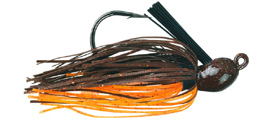All About Bass Fishing - Guide To Fishing Shallow With Jigs
By Rick Seaman and Dan Westfall
 Jigs for shallow water are typically weedless, lead-head jigs with a variety of skirt and trailer materials. They are designed to fish in and around heavy cover. Bass see these jigs as crawfish, frogs or other aquatic forms of food source. Presentation is critical as bass are often on high alert when in shallow water.
Jigs for shallow water are typically weedless, lead-head jigs with a variety of skirt and trailer materials. They are designed to fish in and around heavy cover. Bass see these jigs as crawfish, frogs or other aquatic forms of food source. Presentation is critical as bass are often on high alert when in shallow water.
3 Most Important Factors About Fishing Shallow With Jigs
- It must be weedless to allow entry into heavy cover.
- Proper presentation is critical so as to not spook the bass.
- Boat position is important.
3 Most Effective Fishing Methods & Lures
- Black and blue, weedless jig with a bulky plastic trailer flipped or pitched into or around cover.
- Methodically present the bait to every opening as bass may not move far to take the bait.
- Heavy, stout tackle and line is critical as you may have to pull a big bass from deep in cover.
Fish jigs in shallow water for finicky bass
 When bass move shallow, they may not always be actively feeding. They may be shallow for the comfort of the conditions, but resting deep in cover. Often these bass will not come out of cover to chase lures like spinnerbaits and crankbaits. This is the time to tie on a jig and fish deep within the cover to present a lure right where the bass are holding. Most of the time, if you put it in front of their nose, they will eat it – even when they are not actively feeding.
When bass move shallow, they may not always be actively feeding. They may be shallow for the comfort of the conditions, but resting deep in cover. Often these bass will not come out of cover to chase lures like spinnerbaits and crankbaits. This is the time to tie on a jig and fish deep within the cover to present a lure right where the bass are holding. Most of the time, if you put it in front of their nose, they will eat it – even when they are not actively feeding.
Because the bass are inactive, be aware of soft bites. The bass may simply grab the lure as it falls and not move. Watch your line carefully for twitches or slack line when the bait stops. You may also feel pressure when you begin to move the lure. If so, set the hook.
Although it is a very slow way to cover water, jig fishing is the most thorough way to reach every little nook and cranny where a bass may be hiding. Begin by pitching to the outer edges and openings of the cover. Then move in closer and pitch or flip jigs as tight to the cover as possible. At times you may have to cast to both sides of the trunk and on both sides of major branches to get the bass to bite.
Sometimes bass may choose to hold on vertical trunks while at other times they will prefer horizontal objects like lay-down trees. This can be an important distinction when fishing boat docks and other man-made structures.
Heavy line is important. If you are using monofilament or fluorocarbon, use minimum 20 pound line. For braid, use at least 40 pound. Choose jig weight from ¼ ounce to ¾ ounce. Lighter weights may appeal to inactive bass better than heavy weights. At the same time, heavier jigs allow you to cover more water in a shorter period of time. Find the heaviest weight that works for the day you are fishing.
Water clarity is an important factor. In dirty water use bulky, dark or bright colors. In clear water, natural colors are often a better option to consider.
Rattles can be added to jigs. Some come with a rattle already built in. These rattles can be an added attractant in dirty or dingy water.
AA Bass Fishing Knowledge Base
- Bass Fishing Overview
- Life Cycle Of Bass
- Seasonal Bass Migration
- Bass Migration - Mid to Late Winter
- Bass Migration - Spring
- Bass Migration - Early Summer
- Bass Migration - Late Summer
- Bass Migration - Fall
- Bass Migration - Early Winter
- Fishing For Bass
- It's Now WHAT You Throw, It's WHERE
- Research The Fishery Before You Go
- Review Contour Maps
- Types Of Cover Used By Bass
- Bass Fishing In Grass Beds
- Bass Fishing In Wood & Timber
- Bass Fishing In Brush & Vegetation
- Establishing Patterns
- Learn To Recognize Bites
- Review Lunar Tables
- Choose The Right Lures
- Find Bass Based On Conditions
- Conditions - Fold Fronts
- Conditions - Wind
- Conditions - Cloudy Days
- Conditions - Fishing In The Rain
- Conditions - Water Clarity
- Conditions - Rising Water
- Conditions - Falling Water
- Conditions - Fishing At Night
- Equipment & Tackle
- Equipment - Fishing Rods
- Equipment - Fishing Reels
- Equipment - Fishing Line
- Equipment - Fishing Lures
- Fishing With Live Bait
- Shallow Water Techniques, 0 -10'
- Shallow Fishing - Spinnerbaits
- Shallow Fishing - Crankbaits
- Shallow Fishing - Top Water
- Shallow Fishing - Pitching & Flipping
- Shallow Fishing - Artificial Worms
- Shallow Fishing - Jigs
- Shallow Fishing - Flukes
- Shallow Fishing - Stick Worms
- Shallow Fishing - Swimbaits
- Fishing Mid Range Depths, 10' - 25'
- Mid Depth - Spinnerbaits
- Mid Depth - Deep Diving Crankbaits
- Mid Depth - Artificial Worms
- Mid Depth - Jigs
- Mid Depth - Swimbaits
- Fishing Deep Water & Structure
- Fishing Deep Water - Jigs
- Fishing Deep Water - Jigging Spoons
- Fishing Deep Water - Artificial Worms
- Planning Your Attack
- Bass Fishing Questions & Answers
- Conservation - Protect The Fishery
Bass information by state
101624
Fishing Information



